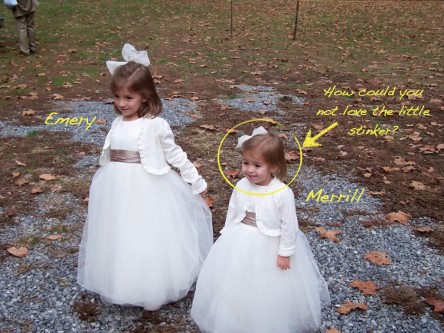Comments Off on Funny things kids say
 Neither one of my nieces has developed a “filter.†You know, that social apparatus which keeps most of us from saying rude, uncomfortable, or politically incorrect things in polite company.
Neither one of my nieces has developed a “filter.†You know, that social apparatus which keeps most of us from saying rude, uncomfortable, or politically incorrect things in polite company.
Emery, the older one, will say things like “Mommy, your breath is stinky,†or “Why is that lady so big?â€
Merrill, the younger one, has trouble pronouncing her F’s, S’s, and Th’s, and she loves being the center of attention. The other day she wanted everybody to get in a “tircle†and watch her “pin†in the middle. Translation: get in a circle and watch her spin.
The family had a pish named Pipper. Translation: a fish named Flipper.
When I saw them the other day, I said, “Okay, you bunch of stinkers, who’s the biggest stinker in the group?†Merrill did not hesitate to raise her hand. She’ll be four in December.
My sister and brother-in-law told her that if she continued to get out of bed and wander around the house in the middle of the night then she’d get a spanking with a wooden spoon. One night soon after, Merrill woke up her mom. Merrill was holding a wooden spoon in one hand.
At least she was prepared to accept the consequences of her actions.
All my sister could do was laugh.
But then kids say things that you’re glad to be able to address without the added discomfort of stranger’s ears. My sister and brother-in-law have a chocolate Lab named Duke.
Merrill asked if he were an African American.
After the kids started noticing differences and asking questions about skin color, Elizabeth and Jim started trying to help them navigate the race obstacle course.
I can see the simple syllogisms popping up in Merrill’s quick brain:
Brown = African American
Duke = Brown
Therefore, Duke must be an African American.
“No, Merrill, Duke is not an African American. Duke is a dog. African Americans are people.â€
How do you explain family, genus, and species to a four-year-old? How do you stress the importance of showing everyone respect, regardless of skin color, without placing so much emphasis on labels and titles that they turn someone into the “other,†the “them†that is so different than us? Labels quickly become counter-productive when adults use them, so how do you explain such nuances to children?
Megan and I brought Hemingway the Cat to Nashville to meet Emery, Merrill, and Henderson. Merrill liked the kitty so much that she started poking his genitals.
Elizabeth also had to address this issue: “Merrill, please don’t poke Hemingway’s privates. He doesn’t like that, and animal privates are like people privates. You don’t touch them.â€
Merrill is fond of taking things that she has heard and making them about her. A little boy pushed Emery down at school, and Merrill started telling people that a little boy pushed her down in the parking lot. She would even show you the boo boo on her knee. Of course, the skin didn’t have a single mark on it.
She told her mom recently that the husband of one of the teachers at her pre-school had wiped her bottom that day. This was not true.
How do you delineate the difference between storytelling and lying, between make believe and deception? Obviously, an unauthorized adult helping a child in the bathroom is cause for concern, but how do you tell kids that this particular context—bathrooms and “privatesâ€â€”deserves absolute truth and no imagination because of the damage an otherwise harmless story might do?
Parenting is going to be so much fun.
